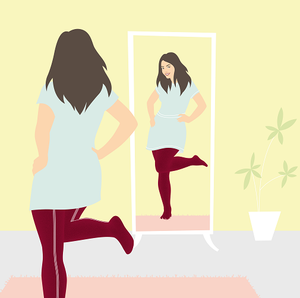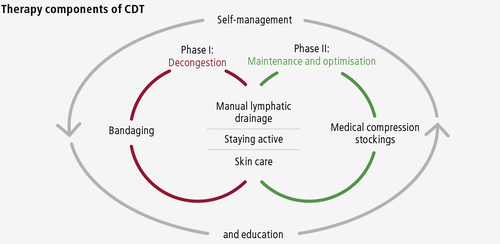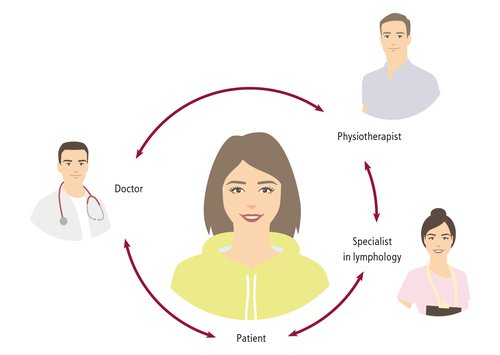Lipedema and self-management
The foundation of the treatment of chronic diseases
Suffering a chronic disease, such as lipedema or lymphedema, means having to undergo constant therapy. The foundation of this usually lifelong treatment is self-management. That’s why all people involved in the treatment chain – such as doctors, therapists and employees at the health care supply store – have to work together to promote the patient’s autonomy. In this article, we’ll explain what self-management means in the context of edema, what it consists of and how you get in control of your illness.
Self-management for chronic diseases
Lipedema and lymphedema patients usually go through a long period of suffering before a diagnosis is made and the appropriate therapy is started. To tackle this, complex decongestive physiotherapy (CDP) has proven to be particularly effective. It consists of manual drainage, medical compression stockings, skin care as well as exercise – and in recent times, self-management has been added to the core elements of this type of therapy. Adhering to these five therapy elements is the prerequisite for living an almost completely self-sufficient life despite a chronic illness.

But what exactly is self-management in the case of lipedema?
Self-management is a term originally coined in the working environment and it describes the ability to independently and autonomously ensure one’s own further development. If you transfer this definition to the context of chronic diseases like lipedema and/or lymphedema, self-management describes the proactive organisation of the everyday life affected by the illness. The patient is supposed to learn the ability to determine their own life. The general consensus of the treatment chain is that patients can only achieve this if they are mature people who have been educated about the subject.
How does self-management work?*
One thing is certain: self-management only works for edema patients if the treatment chain works together. The responsibility lies not only with the patient – they also need teachers and mentors who will provide advice and knowledge.
In a best-case scenario, these roles are as follows:

- The lymph drainage therapist takes on the role of the teacher. During the manual lymph drainage (MLD), they will pass on knowledge about the human body, the lymphatic system, the clinical picture and the different therapy options. Furthermore, decongestive movement and breathing exercises, tips on bandaging at home and techniques preventing edema at work and in everyday life should also be taught.
- The health care supply store and their employees support the physiotherapist in their function and provide helpful additional information around the subject of compression garments. What types of materials are there? How do I put on and take off my compression tights? How often can I wash the stockings and are there any additional measures that promote the therapy? These questions should primarily be answered by the employees at the health care supply store.
- The (specialist) doctor acts as a controller in this treatment chain. How does the edema develop? Does the compression garment need adjusting? Do side effects occur? It is the doctor’s responsibility to observe and record these types of developments. By thoroughly and regularly talking to your doctor about your medical progress, the resulting findings and diagnoses can help your doctor identify the appropriate measures to improve your situation.

- The most important role is played by the patient, however. Without them and their drive, success is not possible. Appointments with the different individuals in the treatment chain have to be coordinated and realised. Healthy food and sufficient exercise ensure wellbeing. A perfectly fitted compression garment that matches the personal clothing style promotes self-confidence. But even fear, pain and frustration are part of everyday life. Being able to allow and control those emotions is probably the biggest of all challenges.
*Source: Pritschow, Hans: ‘Compliance, Selbstmanagement, Krankheitsselbstmanagement bei Lymphödemen. Alle reden drüber, kaum jemand weiß, was es bedeutet und wie es umgesetzt werden kann.’ Published in: 'Lymphologie – Geschichte, Gegenwart und Zukunft Festschrift für Dr. med. Christian Schuchhardt anlässlich seines 70. Geburtstages’ Published by Anya Miller, 2015.
Improving the quality of life – a suggestion
Prof. Dr. Daubert, lecturer for manual lymphatic drainage at the SRH Fachhochschule für Gesundheit Gera, summarises what the entire treatment chain would have to do in order to improve the patient’s quality of life. She points out that the psychological aspect and the guidance for self-help is usually overlooked during the CDP – and it’s therefore also rarely taken into account by health insurances. For her, it is paramount that this attitude is changed – patients should be able to manage their own lives and thus improve their quality of life. Everyday life with an edema is ultimately not just a physical, but also a psychological challenge.
A therapy plan or a lymph diary can help with structuring your daily routine and to stay on top of things. Even a little stitched-in heart can sometimes act as a little motivation booster, even if just for a moment. There are many ways and methods to gain courage – like sharing experiences in a self-help group, a photo shoot or a performance in front of a larger audience. Find out more about this in our stories of encouragement.

Components of self-management
Self-management is a discipline that never ends and that consists of many different elements. The primary goal of self-management is to gain knowledge in the various categories and to derive possible actions out of this. Knowledge in the sub-disciplines of exercise, nutrition, skin care, manual lymphatic drainage or compression is indispensable.
But in our view, a big part of this is also self-love. We think that accepting, appreciating and loving yourself and your own body is the key component of self-management. That’s why we stitch a little heart into the foot area or the hem of a sleeve upon request. It is designed to remind patients that they are important and that their requirements are always at the heart of the therapy. Because patients matter – always!
Components of self-management
Goals of self-management
The goal of self-management is for edema patients to independently manage their illness. Having knowledge in all aspects of the illness and being able to use it is the ultimate objective of self-management. This way, patients achieve maximum freedom and independence which allows them to consistently continue their edema prevention at all times – on holiday, for example. This continuously promotes the general health and holiday-goers will not have to start from scratch again.
By increasing one’s own awareness and learning the right methods, patients can learn to act in a reflective, responsible and healthy manner. What’s more, it requires the treatment chain consisting of doctors, therapists and health care supply stores to pass on their knowledge to the patient. This exchange promotes the understanding and awareness surrounding the edema illness.






